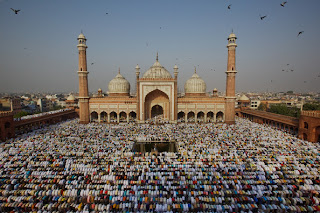 Darjeeling
Darjeeling is a
Himalayan
city in theIndian
state of
West Bengal. It is internationally renowned as a tourist destination, along with its
tea industry
and the
Darjeeling Himalayan Railway, a
UNESCO
World Heritage Site. It is "hill town headquarters" of
Darjeeling district
with a partially autonomous status within the state of West Bengal. The town is located in the
Mahabharat Range
orLesser Himalaya
at an average elevation of 6,710 ft (2,050 m).
The development of the town dates back to the mid-19th century, when the British set up a sanatorium and a military depot. Subsequently, extensive tea plantation was done in the region, and tea growers developed distinctive hybrids of black tea and created new fermenting techniques. The resultant distinctive Darjeeling tea is internationally recognised and ranks among the most popular of the black teas. The Darjeeling Himalayan Railway connects the town with the plains and has one of the few steam locomotives still in service in India. Darjeeling also has several British-style public schools, which attract students from throughout India and neighbouring countries. The town, with its neighbouring town of Kalimpong, was a center for the demand of theGorkhaland movement in the 1980s. The present movement for a separate state of Gorkhaland is also centered in Darjeeling town. In recent years, the town's fragile ecology has been threatened by a rising demand for environmental resources, stemming from growing tourist traffic and poorly planned urbanisation.
Culture of Darjeeling
Apart from the major religious festivals of Dashain (Durga puja), Tihar (Diwali) and Christmasthe diverse ethnic populace of the town celebrates several local festivals. The Lepchas and Bhutias celebrate new year in January, while Tibetans celebrate their new year, Losar, in February–March. The birthday of the Lord Buddha is celebrated in mid-June with processions.Darjeeling Carnival, initiated by a civil society movement known as The Darjeeling Initiative, is a ten day carnival held every year during the winter with portrayal of the Darjeeling Hill's musical and cultural heritage as its central theme.
A popular food in Darjeeling is the Tibetan momo, a steamed dumpling containing meat cooked in a doughy wrapping and served with clear soup and achar. A form of Tibetan noodle called thukpa, served in soup form is also popular. Other commonly eaten dishes include alu dum, a potato preparation, and shaphalay, Tibetan bread stuffed with meat. Fermented foods and beverages are consumed by a large percentage of the population. Fermented foods include preparations of soyabean, bamboo shoots, milk and Sel roti, which is made from rice. Tea is the most popular beverage, the Tibetan version is also drunk.Alcoholic beverages include Tongba, Jnaard and Chhaang, variations of a local beer made from fermenting finger millet.
Education of Darjeeling
There are 52 primary schools, 21 high schools and 4 colleges in the town. Darjeeling's schools are either run by the state government or by private and religious organisations. Schools mainly use English and Nepali as their media of instruction, although there is the option to learn the national language Hindi and the official state language Bengali. The schools are either affiliated with the ICSE, the CBSE, or the West Bengal Board of Secondary Education. Having been a summer retreat for the British in India, Darjeeling became the place of choice for the establishment of public schools on the model of Eton, Harrow and Rugby, allowing the children of British officials to obtain an exclusive education. Institutions such as Mount Hermon School, St. Robert's H.S. School St. Joseph's College (School Dept.), Loreto Convent,and St. Paul's School are renowned as centres of educational excellence. Darjeeling has four colleges — St. Joseph's College, Southfield College (earlier known as Loreto College), Darjeeling Government College and Sri Ramakrishna B.T. College — all affiliated to the University of North Bengal in Siliguri.



.jpg)











.jpg)



